DODGE AVENGER 2008 Owners Manual
Manufacturer: DODGE, Model Year: 2008, Model line: AVENGER, Model: DODGE AVENGER 2008Pages: 467, PDF Size: 7.16 MB
Page 401 of 467
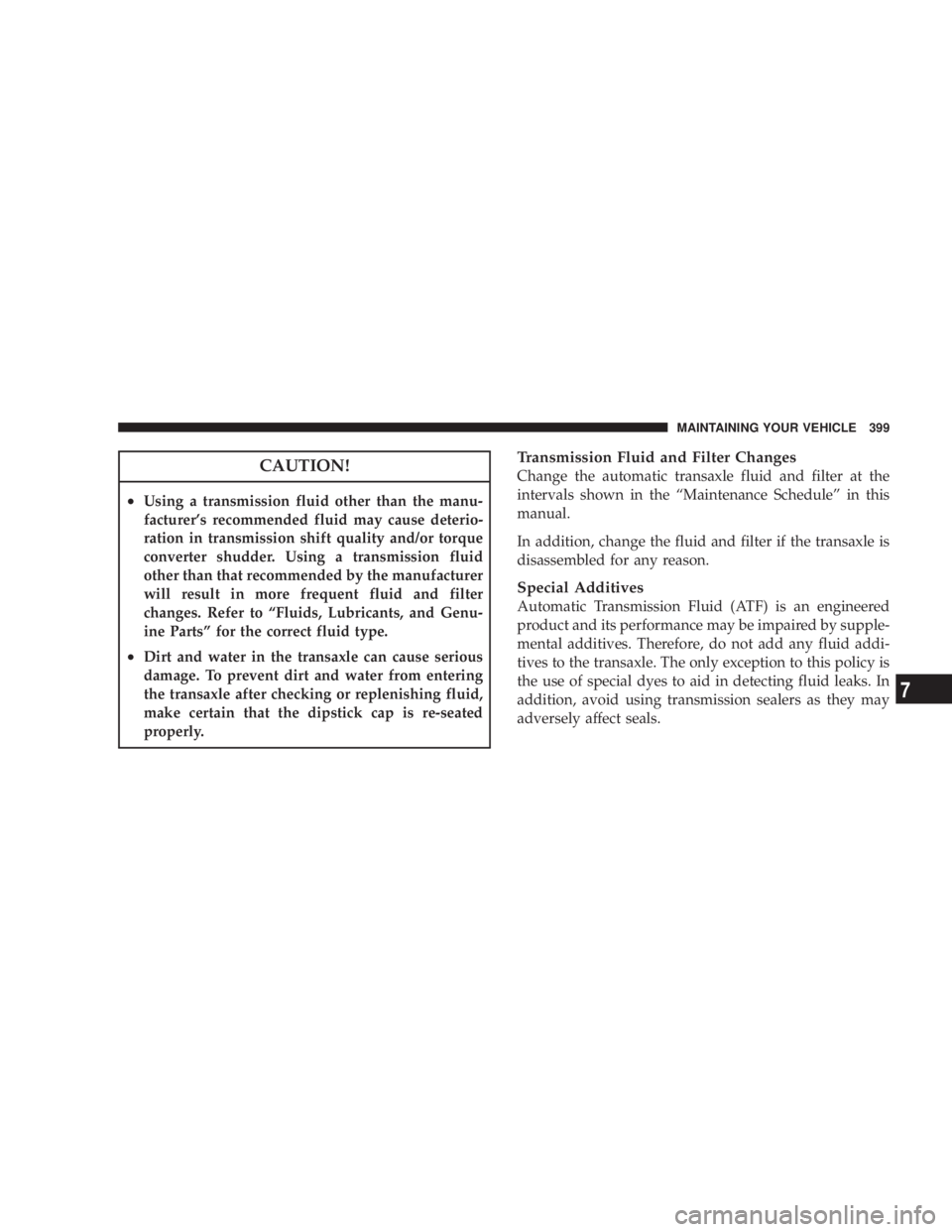
CAUTION!² Using a transmission fluid other than the manu-
facturer's recommended fluid may cause deterio-
ration in transmission shift quality and/or torque
converter shudder. Using a transmission fluid
other than that recommended by the manufacturer
will result in more frequent fluid and filter
changes. Refer to ªFluids, Lubricants, and Genu-
ine Partsº for the correct fluid type.
² Dirt and water in the transaxle can cause serious
damage. To prevent dirt and water from entering
the transaxle after checking or replenishing fluid,
make certain that the dipstick cap is re-seated
properly. Transmission Fluid and Filter Changes
Change the automatic transaxle fluid and filter at the
intervals shown in the ªMaintenance Scheduleº in this
manual.
In addition, change the fluid and filter if the transaxle is
disassembled for any reason.
Special Additives
Automatic Transmission Fluid (ATF) is an engineered
product and its performance may be impaired by supple-
mental additives. Therefore, do not add any fluid addi-
tives to the transaxle. The only exception to this policy is
the use of special dyes to aid in detecting fluid leaks. In
addition, avoid using transmission sealers as they may
adversely affect seals. MAINTAINING YOUR VEHICLE 399
7
Page 402 of 467
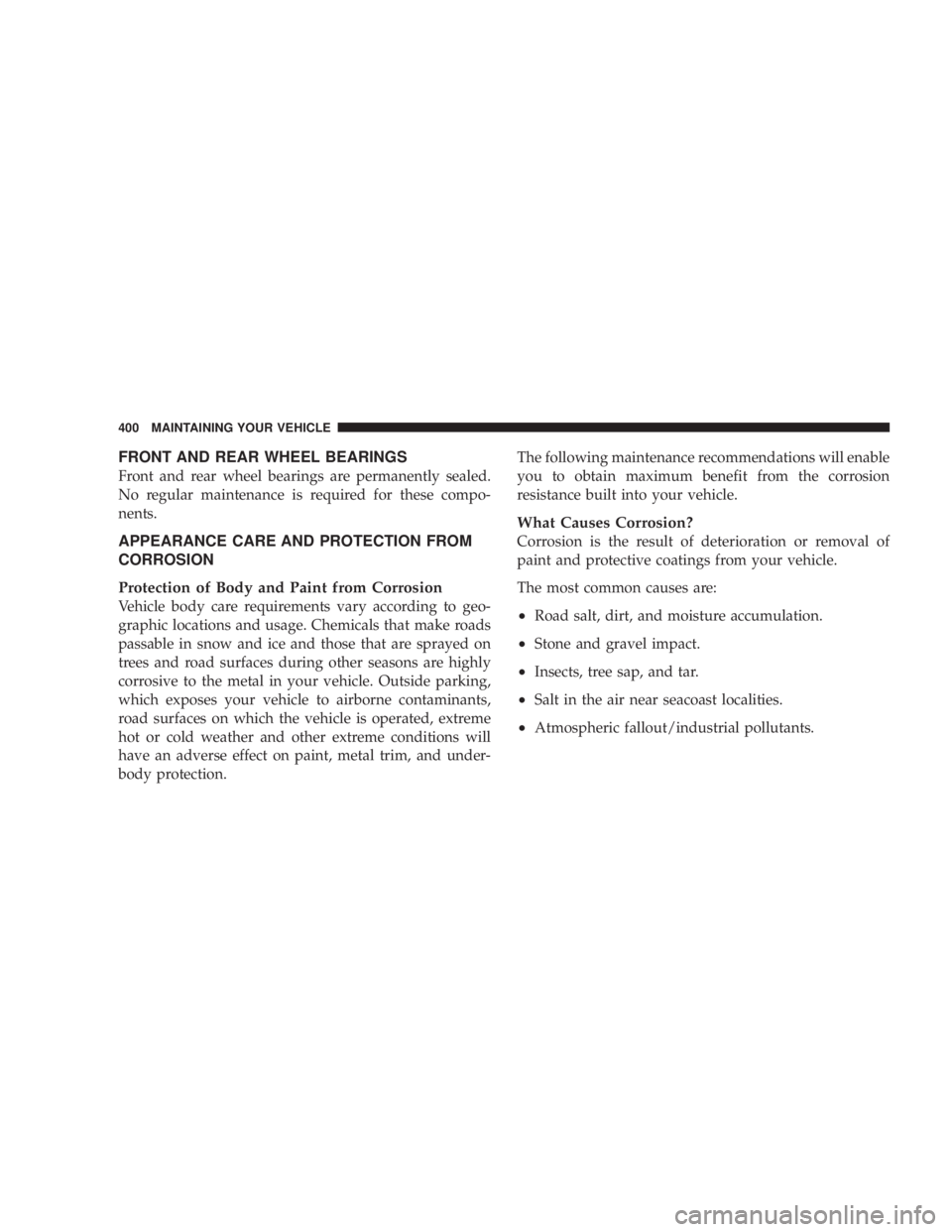
FRONT AND REAR WHEEL BEARINGS
Front and rear wheel bearings are permanently sealed.
No regular maintenance is required for these compo-
nents.
APPEARANCE CARE AND PROTECTION FROM
CORROSION
Protection of Body and Paint from Corrosion
Vehicle body care requirements vary according to geo-
graphic locations and usage. Chemicals that make roads
passable in snow and ice and those that are sprayed on
trees and road surfaces during other seasons are highly
corrosive to the metal in your vehicle. Outside parking,
which exposes your vehicle to airborne contaminants,
road surfaces on which the vehicle is operated, extreme
hot or cold weather and other extreme conditions will
have an adverse effect on paint, metal trim, and under-
body protection. The following maintenance recommendations will enable
you to obtain maximum benefit from the corrosion
resistance built into your vehicle.
What Causes Corrosion?
Corrosion is the result of deterioration or removal of
paint and protective coatings from your vehicle.
The most common causes are:
² Road salt, dirt, and moisture accumulation.
² Stone and gravel impact.
² Insects, tree sap, and tar.
² Salt in the air near seacoast localities.
² Atmospheric fallout/industrial pollutants.400 MAINTAINING YOUR VEHICLE
Page 403 of 467
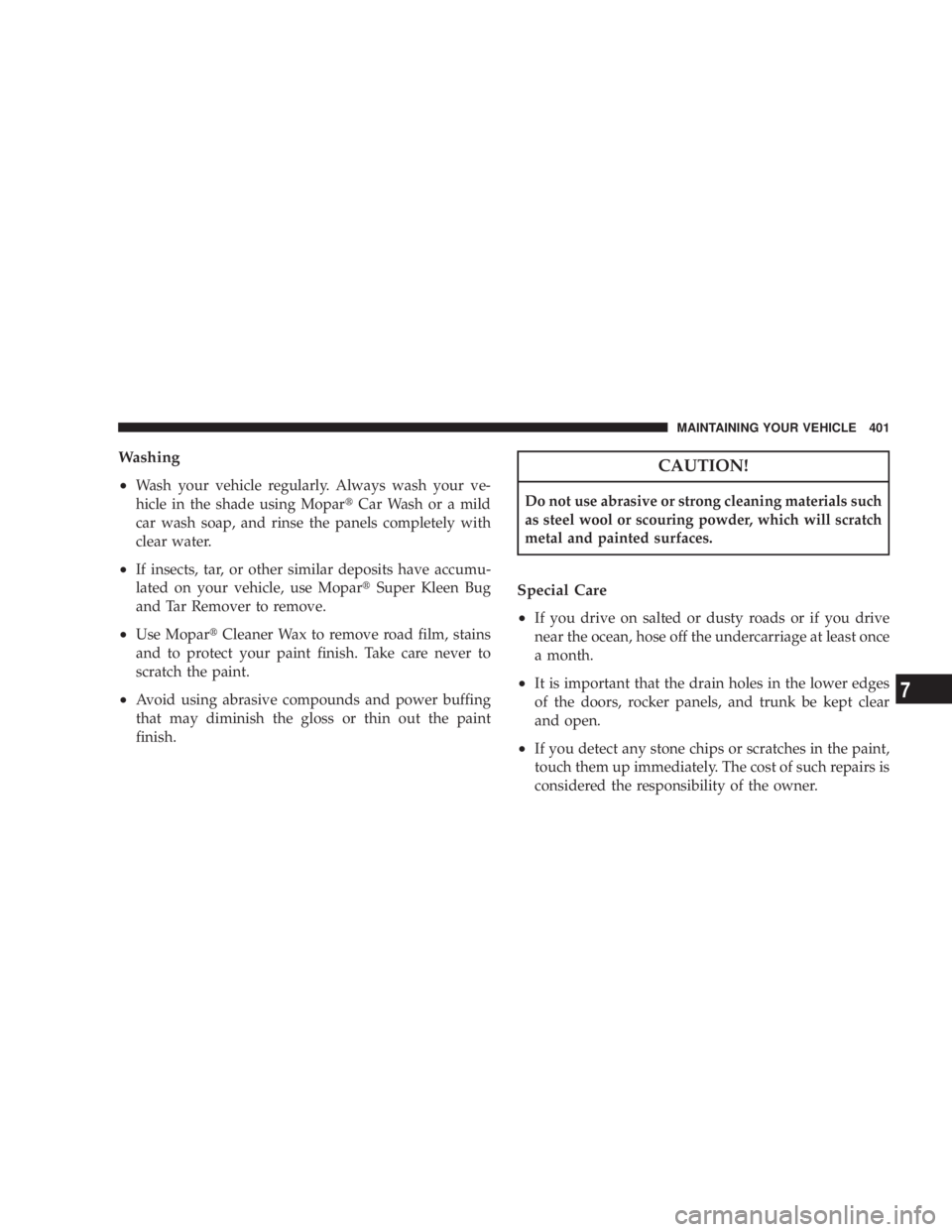
Washing
² Wash your vehicle regularly. Always wash your ve-
hicle in the shade using Mopar t Car Wash or a mild
car wash soap, and rinse the panels completely with
clear water.
² If insects, tar, or other similar deposits have accumu-
lated on your vehicle, use Mopar t Super Kleen Bug
and Tar Remover to remove.
² Use Mopar t Cleaner Wax to remove road film, stains
and to protect your paint finish. Take care never to
scratch the paint.
² Avoid using abrasive compounds and power buffing
that may diminish the gloss or thin out the paint
finish. CAUTION!Do not use abrasive or strong cleaning materials such
as steel wool or scouring powder, which will scratch
metal and painted surfaces.
Special Care
² If you drive on salted or dusty roads or if you drive
near the ocean, hose off the undercarriage at least once
a month.
² It is important that the drain holes in the lower edges
of the doors, rocker panels, and trunk be kept clear
and open.
² If you detect any stone chips or scratches in the paint,
touch them up immediately. The cost of such repairs is
considered the responsibility of the owner. MAINTAINING YOUR VEHICLE 401
7
Page 404 of 467
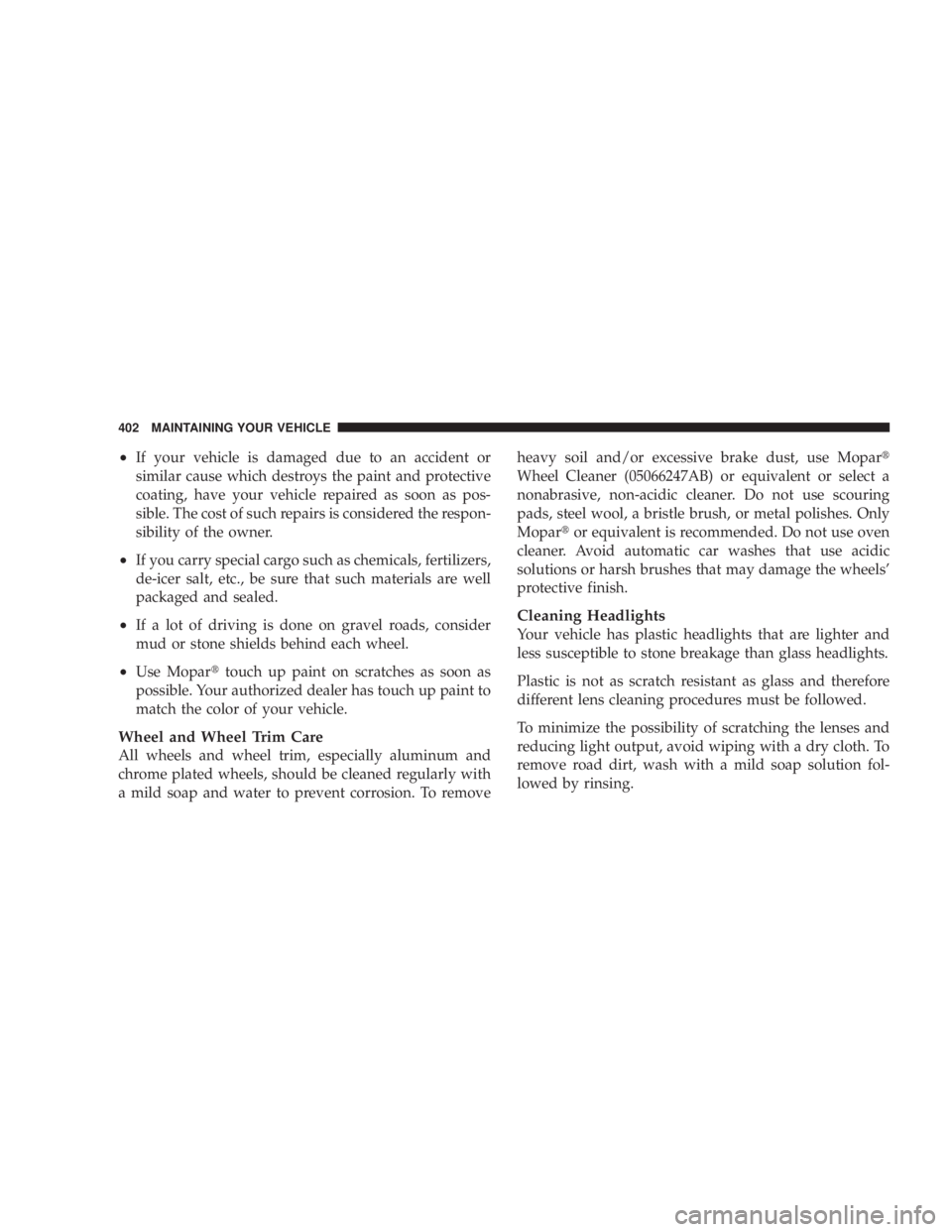
² If your vehicle is damaged due to an accident or
similar cause which destroys the paint and protective
coating, have your vehicle repaired as soon as pos-
sible. The cost of such repairs is considered the respon-
sibility of the owner.
² If you carry special cargo such as chemicals, fertilizers,
de-icer salt, etc., be sure that such materials are well
packaged and sealed.
² If a lot of driving is done on gravel roads, consider
mud or stone shields behind each wheel.
² Use Mopar t touch up paint on scratches as soon as
possible. Your authorized dealer has touch up paint to
match the color of your vehicle.
Wheel and Wheel Trim Care
All wheels and wheel trim, especially aluminum and
chrome plated wheels, should be cleaned regularly with
a mild soap and water to prevent corrosion. To remove heavy soil and/or excessive brake dust, use Mopar t
Wheel Cleaner (05066247AB) or equivalent or select a
nonabrasive, non-acidic cleaner. Do not use scouring
pads, steel wool, a bristle brush, or metal polishes. Only
Mopar t or equivalent is recommended. Do not use oven
cleaner. Avoid automatic car washes that use acidic
solutions or harsh brushes that may damage the wheels'
protective finish.
Cleaning Headlights
Your vehicle has plastic headlights that are lighter and
less susceptible to stone breakage than glass headlights.
Plastic is not as scratch resistant as glass and therefore
different lens cleaning procedures must be followed.
To minimize the possibility of scratching the lenses and
reducing light output, avoid wiping with a dry cloth. To
remove road dirt, wash with a mild soap solution fol-
lowed by rinsing.402 MAINTAINING YOUR VEHICLE
Page 405 of 467

Do not use abrasive cleaning components, solvents, steel
wool or other aggressive material to clean the lenses.
Interior Care
Instrument Panel Cover
The instrument panel cover has a low glare surface,
which minimizes reflections in the windshield. Do not
use protectants or other products, which may cause
undesirable reflections. Use soap and warm water to
restore the low glare surface.
Cleaning Interior Trim
Interior Trim should be cleaned starting with a damp
cloth, a damp cloth with Mopar t Total Clean, then
Mopar t Spot & Stain Remover if absolutely necessary. Do
not use harsh cleaners or Armorall. Use Mopar t Total
Clean to clean vinyl upholstery Cleaning Leather Upholstery
Mopar t Total Clean is specifically recommended for
leather upholstery.
Your leather upholstery can be best preserved by regular
cleaning with a damp soft cloth. Small particles of dirt
can act as an abrasive and damage the leather upholstery
and should be removed promptly with a damp cloth.
Stubborn soils can be removed easily with a soft cloth
and Mopar t Total Clean. Care should be taken to avoid
soaking your leather upholstery with any liquid. Please
do not use polishes, oils, cleaning fluids, solvents, deter-
gents, or ammonia-based cleaners to clean your leather
upholstery. Application of a leather conditioner is not
required to maintain the original condition. MAINTAINING YOUR VEHICLE 403
7
Page 406 of 467
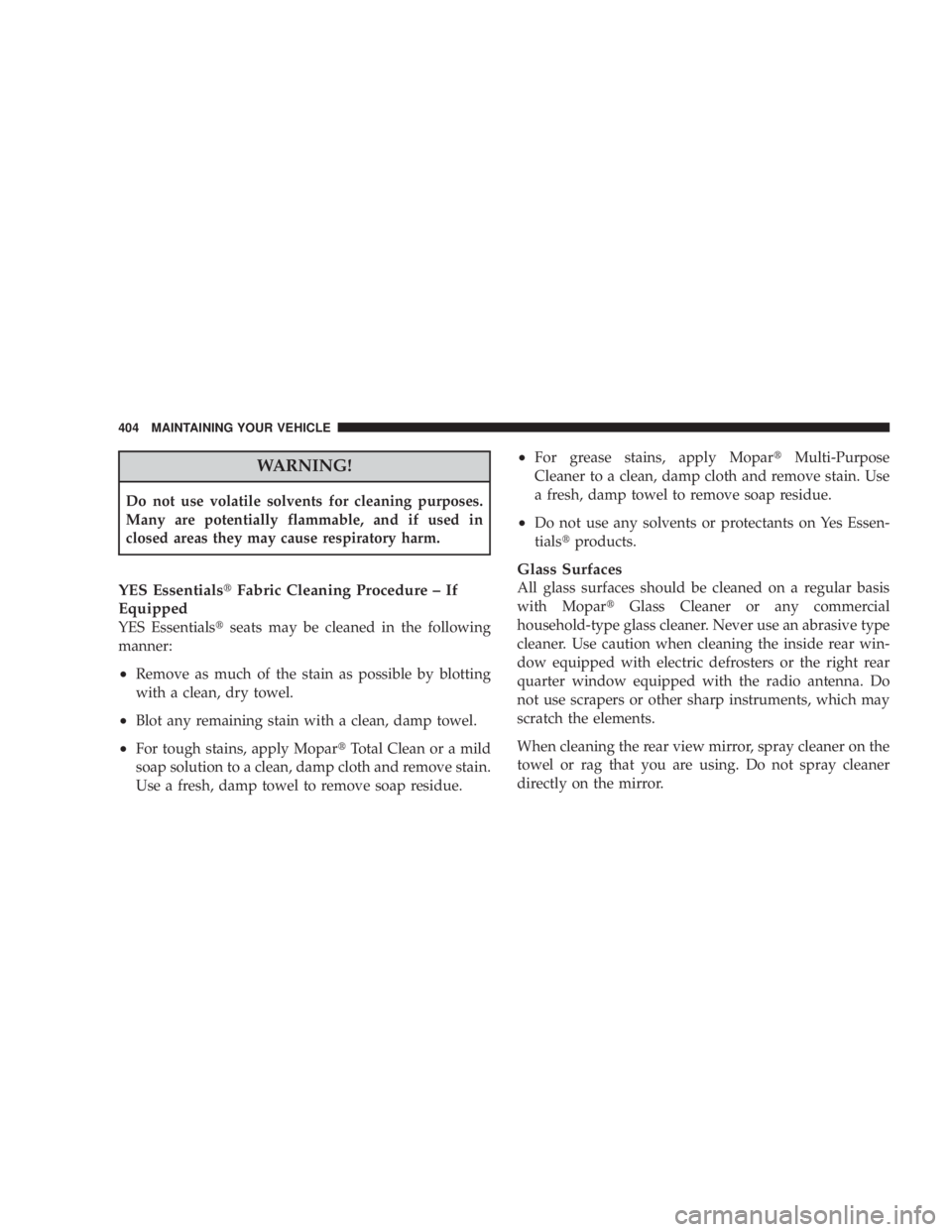
WARNING!Do not use volatile solvents for cleaning purposes.
Many are potentially flammable, and if used in
closed areas they may cause respiratory harm.
YES Essentials t Fabric Cleaning Procedure ± If
Equipped
YES Essentials t seats may be cleaned in the following
manner:
² Remove as much of the stain as possible by blotting
with a clean, dry towel.
² Blot any remaining stain with a clean, damp towel.
² For tough stains, apply Mopar t Total Clean or a mild
soap solution to a clean, damp cloth and remove stain.
Use a fresh, damp towel to remove soap residue. ² For grease stains, apply Mopar t Multi-Purpose
Cleaner to a clean, damp cloth and remove stain. Use
a fresh, damp towel to remove soap residue.
² Do not use any solvents or protectants on Yes Essen-
tials t products.
Glass Surfaces
All glass surfaces should be cleaned on a regular basis
with Mopar t Glass Cleaner or any commercial
household-type glass cleaner. Never use an abrasive type
cleaner. Use caution when cleaning the inside rear win-
dow equipped with electric defrosters or the right rear
quarter window equipped with the radio antenna. Do
not use scrapers or other sharp instruments, which may
scratch the elements.
When cleaning the rear view mirror, spray cleaner on the
towel or rag that you are using. Do not spray cleaner
directly on the mirror.404 MAINTAINING YOUR VEHICLE
Page 407 of 467
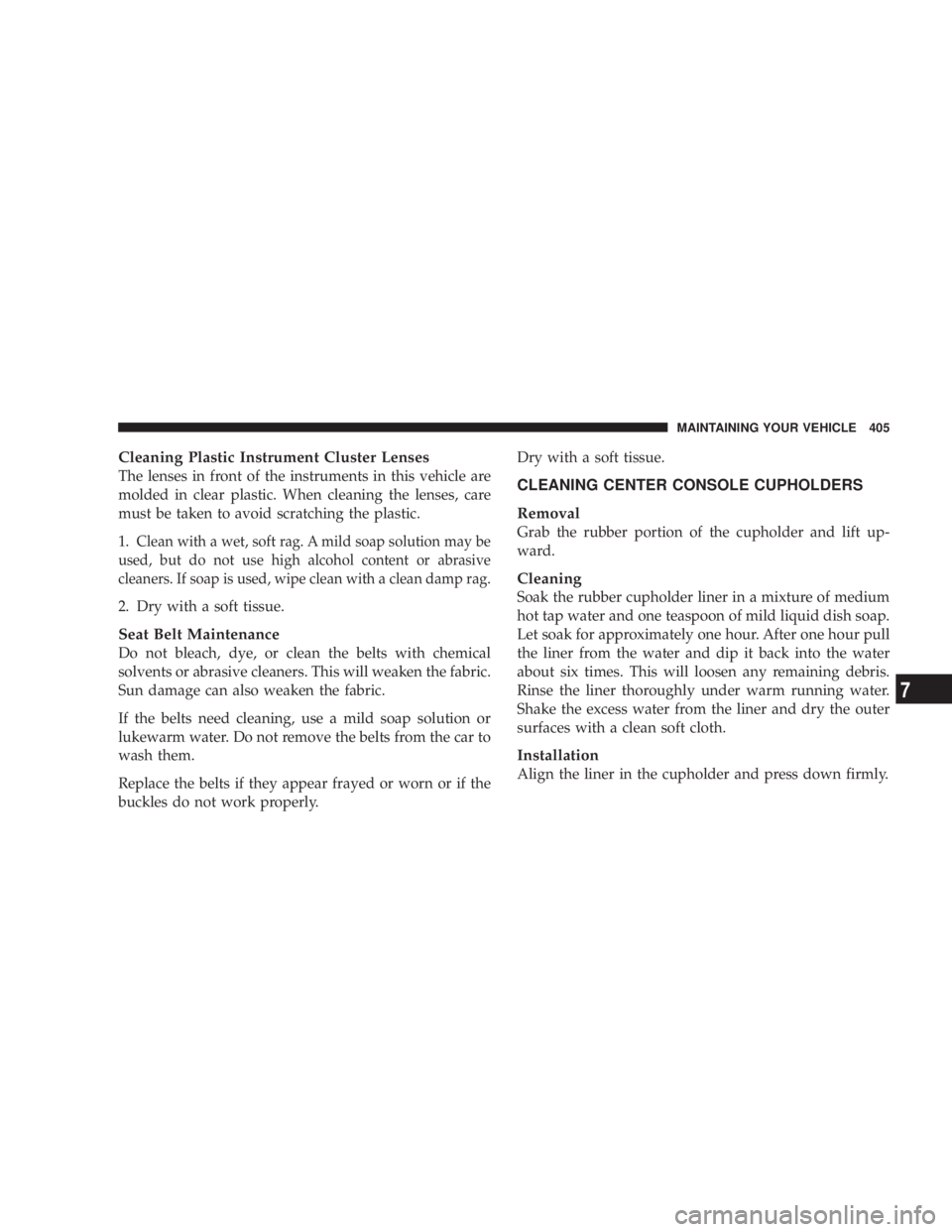
Cleaning Plastic Instrument Cluster Lenses
The lenses in front of the instruments in this vehicle are
molded in clear plastic. When cleaning the lenses, care
must be taken to avoid scratching the plastic.
1.
Clean with a wet, soft rag. A mild soap solution may be
used, but do not use high alcohol content or abrasive
cleaners. If soap is used, wipe clean with a clean damp rag.
2. Dry with a soft tissue.
Seat Belt Maintenance
Do not bleach, dye, or clean the belts with chemical
solvents or abrasive cleaners. This will weaken the fabric.
Sun damage can also weaken the fabric.
If the belts need cleaning, use a mild soap solution or
lukewarm water. Do not remove the belts from the car to
wash them.
Replace the belts if they appear frayed or worn or if the
buckles do not work properly. Dry with a soft tissue.
CLEANING CENTER CONSOLE CUPHOLDERS
Removal
Grab the rubber portion of the cupholder and lift up-
ward.
Cleaning
Soak the rubber cupholder liner in a mixture of medium
hot tap water and one teaspoon of mild liquid dish soap.
Let soak for approximately one hour. After one hour pull
the liner from the water and dip it back into the water
about six times. This will loosen any remaining debris.
Rinse the liner thoroughly under warm running water.
Shake the excess water from the liner and dry the outer
surfaces with a clean soft cloth.
Installation
Align the liner in the cupholder and press down firmly. MAINTAINING YOUR VEHICLE 405
7
Page 408 of 467

FUSES Ð TOTALLY INTEGRATED POWER
MODULE (TIPM)
The TIPM is located in the engine compartment near the
air cleaner assembly. This center contains cartridge fuses
and mini fuses. A label that identifies each component
may be printed on the inside of the cover. Refer to the
following chart for FUSES/TIPM location.
Cavity Car-
tridge
Fuse Mini
Fuse Description
1 40 Amp
Green ÐÐTIPM Fuse and Relay Center406 MAINTAINING YOUR VEHICLE
Page 409 of 467
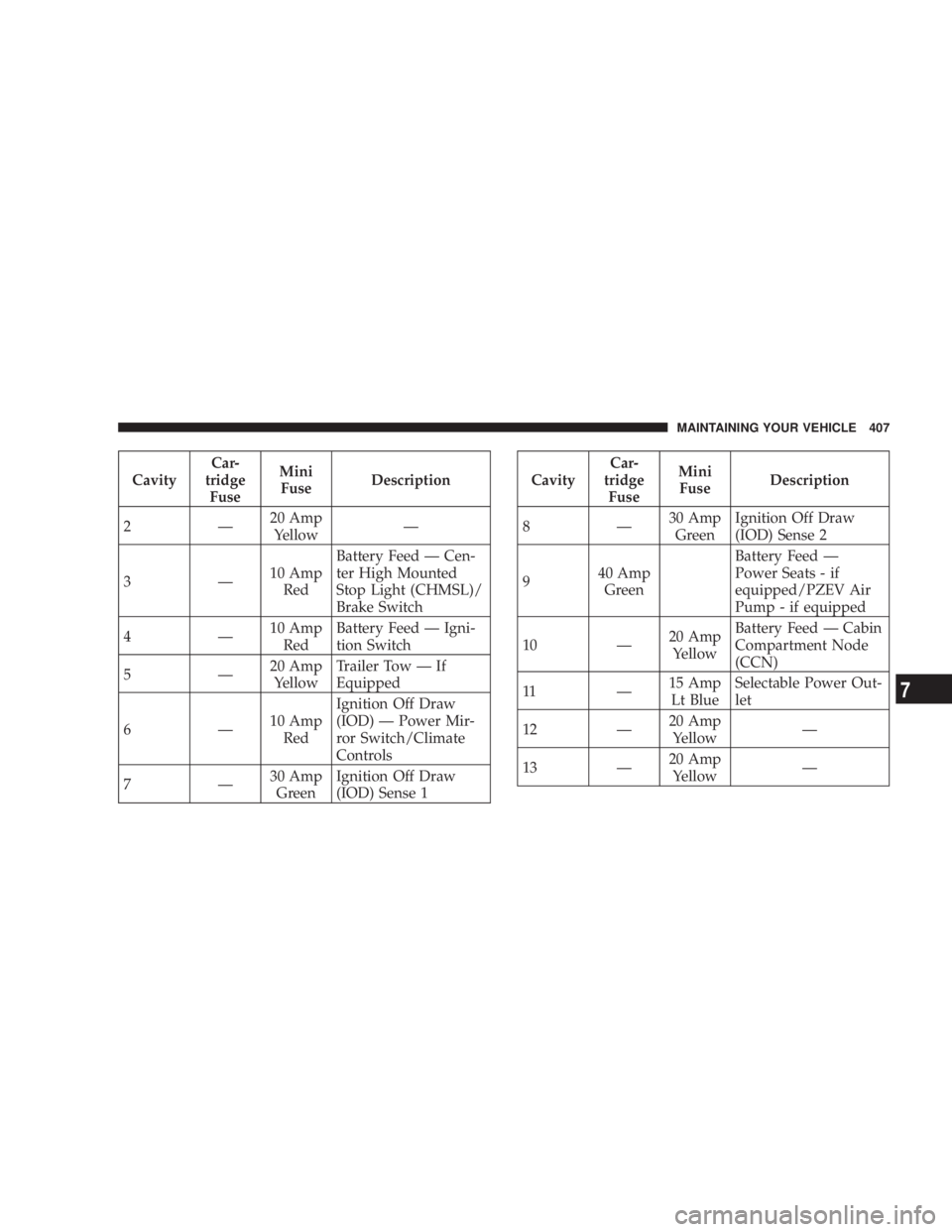
Cavity Car-
tridge
Fuse Mini
Fuse Description
2Ð 20 Amp
Yellow Ð
3Ð 10 Amp
Red Battery Feed Ð Cen-
ter High Mounted
Stop Light (CHMSL)/
Brake Switch
4Ð 10 Amp
Red Battery Feed Ð Igni-
tion Switch
5Ð 20 Amp
Yellow Trailer Tow Ð If
Equipped
6Ð 10 Amp
Red Ignition Off Draw
(IOD) Ð Power Mir-
ror Switch/Climate
Controls
7Ð 30 Amp
Green Ignition Off Draw
(IOD) Sense 1 Cavity Car-
tridge
Fuse Mini
Fuse Description
8Ð 30 Amp
Green Ignition Off Draw
(IOD) Sense 2
9 40 Amp
Green Battery Feed Ð
Power Seats - if
equipped/PZEV Air
Pump - if equipped
10 Ð 20 Amp
Yellow Battery Feed Ð Cabin
Compartment Node
(CCN)
11 Ð 15 Amp
Lt Blue Selectable Power Out-
let
12 Ð 20 Amp
Yellow Ð
13 Ð 20 Amp
Yellow Ð MAINTAINING YOUR VEHICLE 407
7
Page 410 of 467
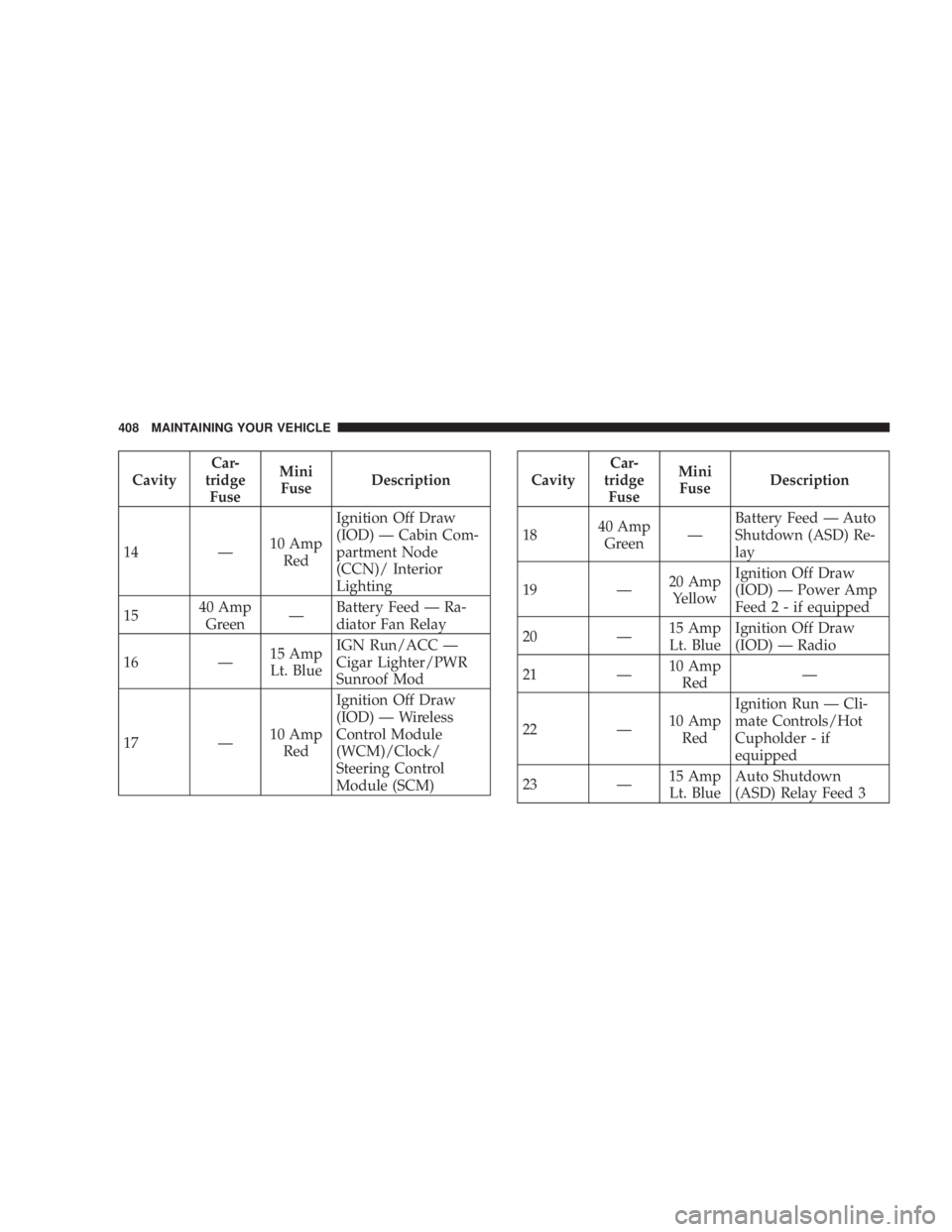
Cavity Car-
tridge
Fuse Mini
Fuse Description
14 Ð 10 Amp
Red Ignition Off Draw
(IOD) Ð Cabin Com-
partment Node
(CCN)/ Interior
Lighting
15 40 Amp
Green Ð Battery Feed Ð Ra-
diator Fan Relay
16 Ð 15 Amp
Lt. Blue IGN Run/ACC Ð
Cigar Lighter/PWR
Sunroof Mod
17 Ð 10 Amp
Red Ignition Off Draw
(IOD) Ð Wireless
Control Module
(WCM)/Clock/
Steering Control
Module (SCM) Cavity Car-
tridge
Fuse Mini
Fuse Description
18 40 Amp
Green Ð Battery Feed Ð Auto
Shutdown (ASD) Re-
lay
19 Ð 20 Amp
Yellow Ignition Off Draw
(IOD) Ð Power Amp
Feed2-if equipped
20 Ð 15 Amp
Lt. Blue Ignition Off Draw
(IOD) Ð Radio
21 Ð 10 Amp
Red Ð
22 Ð 10 Amp
Red Ignition Run Ð Cli-
mate Controls/Hot
Cupholder - if
equipped
23 Ð 15 Amp
Lt. Blue Auto Shutdown
(ASD) Relay Feed 3408 MAINTAINING YOUR VEHICLE